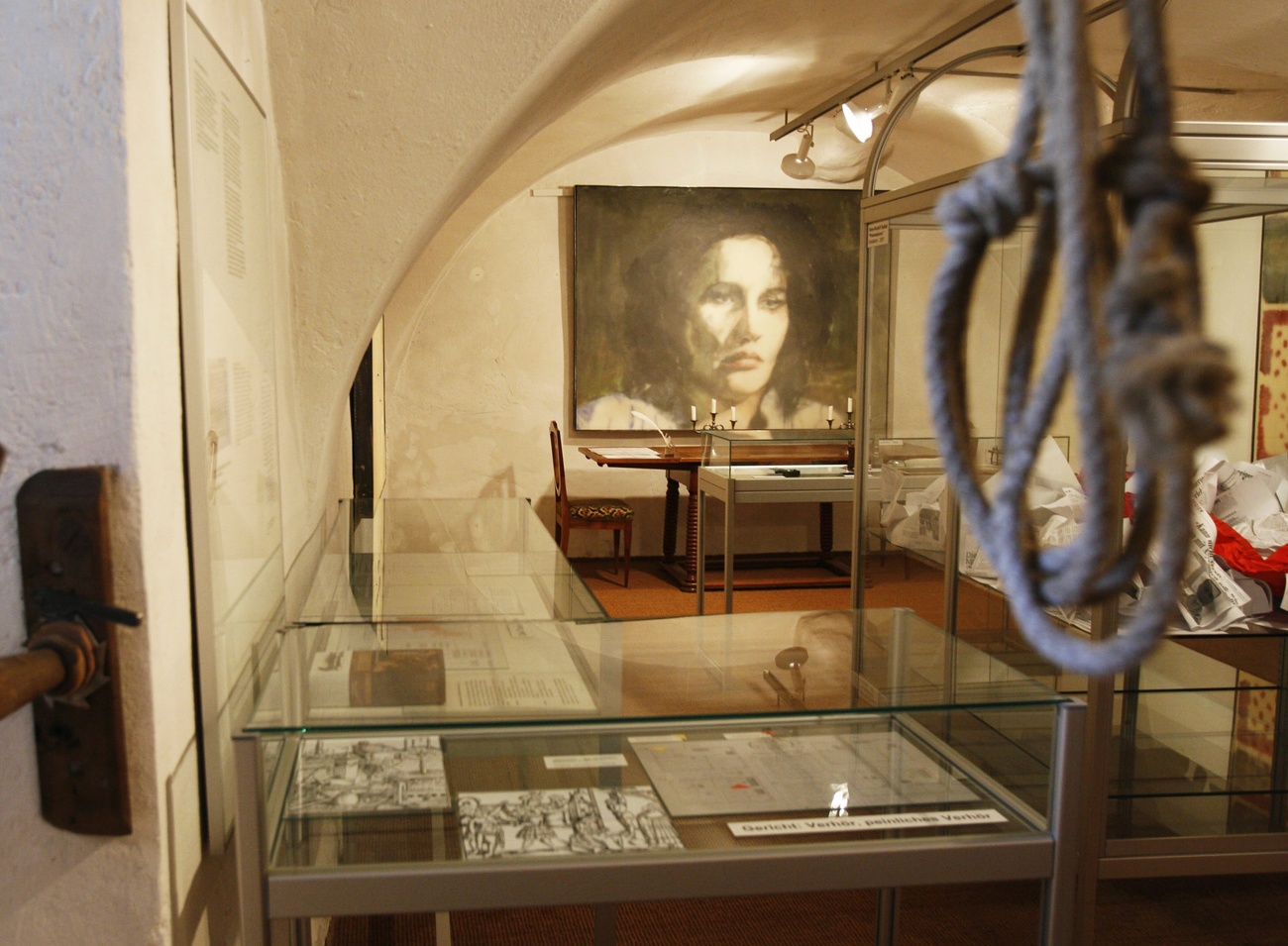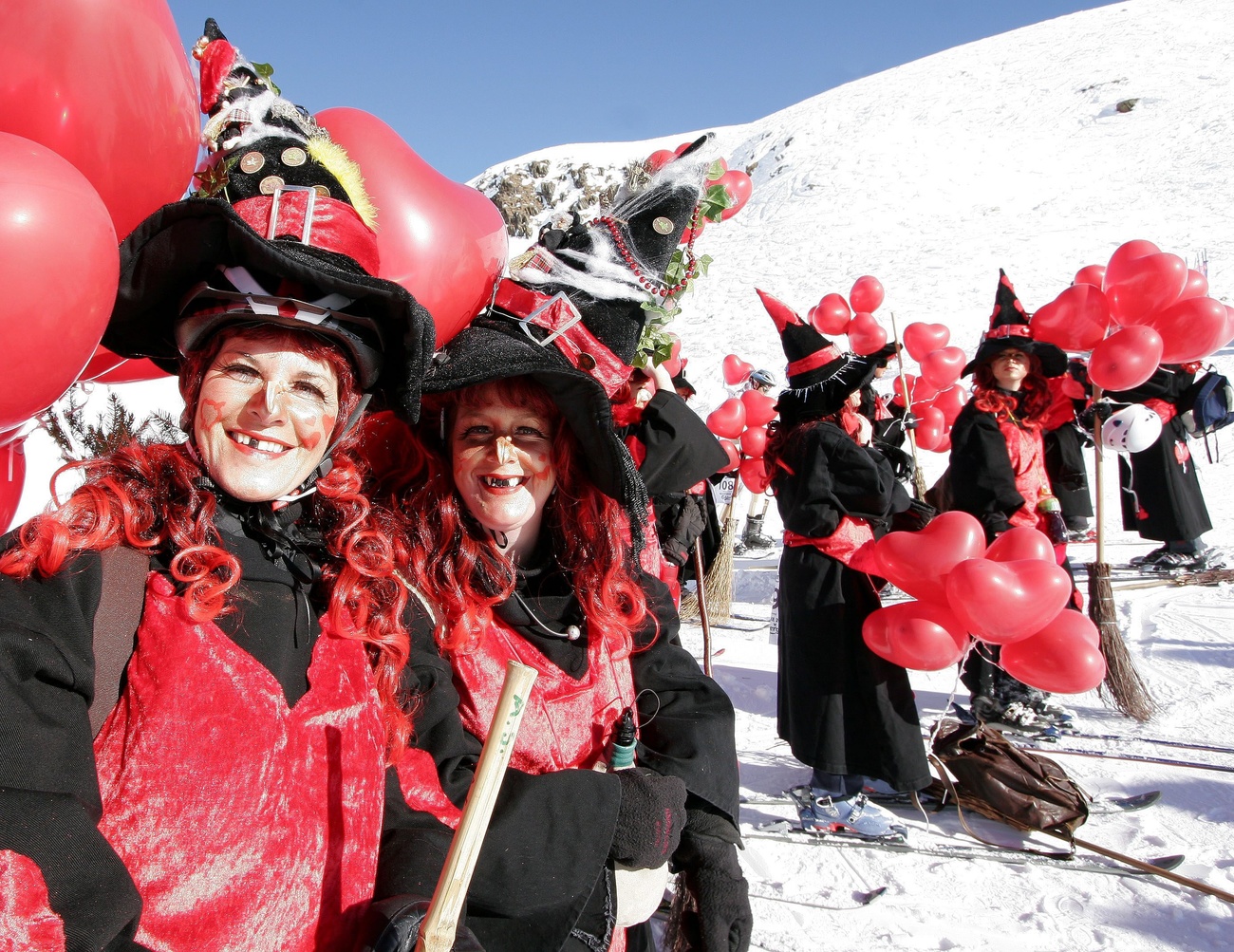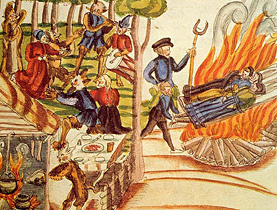Uncovering myths and truths behind Swiss witchcraft trials

Already available online, the witchcraft trials conducted in the Swiss city of Fribourg have now been published in two volumes. These documents challenge a number of preconceived ideas.
Two employees of the Fribourg State Archives, Lionel Dorthe and Rita Binz-Wohlhauser, spent six years studying the various registers and documents relating to 360 witchcraft trials conducted between 1493 and 1741 by the court of the city of Fribourg. Available onlineExternal link since last year, these archives have recently been published in two volumes by The Law Sources Foundation of the Swiss Lawyers SocietyExternal link.
The value of these documents goes beyond the strictly local context.
“Usually, research is limited to a specific period or event,” says Dorthe. Having all the documented witch trials for such a long period is a first, and can serve as a point of comparison for other regions of the world.”
A phenomenon of the Ancien Régime
The public often associates witch trials with the Middle Ages and the Inquisition. But this view is only partially correct.
“It is generally thought that these persecutions date back to the Middle Ages and that it was the Church that dealt with them, when in fact it was a phenomenon of the Ancien Régime,” says Dorthe, referring to the political and social system of the Kingdom of France from the Late Middle Ages until 1789 and the French Revolution. “That’s when most of the trials in Europe and even the United States took place. And they are almost exclusively conducted by secular courts.”
“The phenomenon of persecution certainly appeared at the beginning of the 15th century, which was the last of the Middle Ages,” he says. “At that time, treatises on demonology were being written and people began to believe that a satanic sect was forming that was hostile to Christian society. In fact, it was the Inquisition, mostly led by Dominicans, that began to hunt down people for witchcraft.”
The secular authorities were involved in the process from the outset, but they soon took matters into their own hands and were quick to prosecute people for crimes of witchcraft. The scale of the phenomenon varied. If one takes into account a few registers that have disappeared and include trials in the bailiwicks, it adds up to a total of a thousand trials in 250 years for the whole canton of Fribourg, an average of four a year, which does not constitute a mass phenomenon. In the Pays de Vaud, however, there were 3,000 trials over the same period.
“Not all regions of Europe experienced the same intensity,” says Dorthe. “In regions where power was insecure, such as the Pays de Vaud under Bernese rule, judges used their powers to combat witchcraft. It’s typical: the less power you have, the more you use it. But in regions where power was stronger, such as Fribourg or France, there was no competition for judicial prerogatives and witchcraft trials were not used as political weapons.”
Active public participation
The Fribourg archives show that an accusation of witchcraft could affect almost anyone.
“There are, of course, people who fit the cliché: an elderly woman living alone who practises healing,” says Dorthe. “But you can’t pin down a typical profile; there are also men and even children. The social background is also diverse, with, for example, a squire who was a judge in a bailiwick and who was accused of witchcraft.”
In such a context, specialists avoid the traditional term “witch hunt”, because the phenomenon also concerned men in a third of cases. But also because the term “hunt” refers to voluntary and targeted action by the authorities.
“But the phenomenon is more complex,” notes the archivist. “Without the participation of the population, a relative or neighbour, and without the belief in the devil and magic, the edifice collapses.”

“Accusations of witchcraft are an outlet for explaining the misfortunes of the times or personal misfortunes,” he continues. “It’s an ideal way of getting rid of a neighbour you don’t like or an intrusive mother-in-law. If a young child dies, we try to find the person responsible, especially if that person is a midwife or healer. If a farmer notices a sharp drop in the yield of his cows, he will also look for a scapegoat. In Fribourg, where there’s a big dairy industry, neighbours are regularly accused of using magic formulas to ‘draw the milk’ from the cows and transfer it into the udders of their own animals.”
Not always death
The public often associates witch trials with scenes of torture and death at the stake. This view is not wrong, but while the justice of the time was harsh, it was not necessarily blind.
“Judges used torture, but not systematically. Moreover, it was only a tool. Torture existed to help the course of justice,” says Dorthe. “We must avoid any anachronism by basing our emotions and beliefs on those of the past. We must not regard judges as sadists. They have to do their job, and the laws of the time allowed them to use torture to loosen tongues.”
Death was not necessarily the end of the road for those suspected. In 40% of cases, trials resulted in a sentence of exile (the convicted person had to leave the canton) or internal banishment (they were confined to their parish and forbidden to leave). The death penalty was imposed in less than a third (30%) of trials.
For crimes of witchcraft, death was by burning at the stake. In half of the 80 executions recorded in Fribourg, the sentence was “mitigated”, i.e. softened. To prevent the condemned person from dying by the action of the flames, he or she was first strangled. Sometimes, a small bag of gunpowder was placed around the neck so that it explodes before burning.
Appropriated by feminists
Today, persecution for the crime of witchcraft is presented as a phenomenon that affected women exclusively. But this representation is not supported by the archives.
“The feminist figure of the witch does not correspond at all to the historical sources,” points out Dorthe. “This idea that the witch was an independent woman who attracted the hatred of the patriarchy is false.”

“This feminisation of the phenomenon has its origins in La sorcière, an essay by Jules Michelet,” he adds. “This 19th-century French historian transformed the witch into an ideal or idealised victim, a figure of struggle against all authority. This image corresponds more to the very romantic aspirations of the 19th century than to historical fact. Many feminists took up this image of the emancipated or emancipating witch from the 1960s onwards.”
But this appropriation doesn’t bother Dorthe too much.
“As scientists, we’re going to find this process scandalous, because it doesn’t correspond to reality. But in terms of the effectiveness of the discourse we want to have today, it’s probably wiser to use a symbol than to make a big speech. We live in a society where emotion now takes precedence over reason, not least because of social networking. Using an almost familiar figure like the witch is therefore effective, even if this figure is very far removed from historical reality.”

In compliance with the JTI standards
More: SWI swissinfo.ch certified by the Journalism Trust Initiative













You can find an overview of ongoing debates with our journalists here . Please join us!
If you want to start a conversation about a topic raised in this article or want to report factual errors, email us at english@swissinfo.ch.